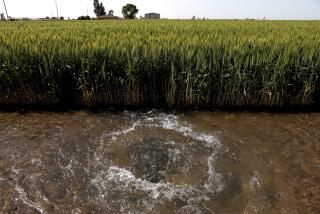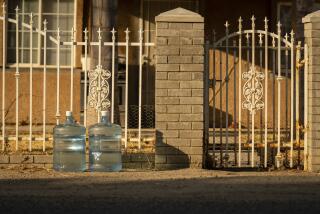California plan to overhaul water system hub to cost $25 billion
The state plan to overhaul the hub of California’s water system will cost nearly $25 billion to build and operate, according to preliminary figures released Wednesday.
The proposal, backed by Gov. Jerry Brown’s administration and the Obama administration, calls for habitat restoration and the construction of two enormous tunnels to divert water from the Sacramento River and carry it under the Sacramento-San Joaquin Delta to southbound pumps.
Water users, including San Joaquin Valley irrigation districts and urban agencies in Southern California and the Bay Area, would bear roughly two-thirds of the cost, with the rest coming from federal and state sources.
The proposal — in the planning stages for seven years — represents the biggest water supply project in California since the 1960s launch of the State Water Project under Brown’s father, Gov. Pat Brown. But important questions are hanging over it, in particular whether federal fishery agencies will approve operating rules that will deliver the volume of water sought by the contractors who will pay for most of the project.
By building a diversion point on the river in the north delta and restoring more than 100,000 acres of habitat, the contractors hope to escape the endangered species restrictions that have reduced their water deliveries from the delta.
Citing an economic analysis, state water officials said the value of benefits the project would provide outweighed costs by 35% to 40%. Proponents said the new diversion would improve the quality of water deliveries by taking some supplies north of tidal influences and runoff from delta farms. It would also stabilize export amounts by taking less water from the existing, fish-killing south delta facilities and make the water system less vulnerable to earthquake damage.
Under the estimates released by the state, building the tunnels, three large intakes on the river and associated facilities would cost $14.5 billion. Operations and maintenance would amount to $4.8 billion over the 50-year life of the project. Habitat restoration, which would be funded with state bonds and federal appropriations, would cost $4.1 billion.
Since most of the money would come from water users, their participation in the project is crucial. And they are reserving final commitment until still-evolving details of the plan are firmed up.
“We’ve got to be able to say we can make it work under all conditions,” said Roger Patterson, assistant general manager of the Metropolitan Water District of Southern California, which imports supplies from the delta. “There will be some judgment as to where we think things may or may not go.… Under the worst-case scenario, does it still work for us?”
Depending on what operating rules the fishery agencies demand to protect endangered native fish, delta deliveries could increase or decrease compared to the average of the last two decades. If they fall, the water contractors must decide if the project is worth it.
“We need to see a project that provides improved water supply, has affordable costs and enforceable regulatory assurances before we can make any commitments,” Ted Page, board president of the Kern County Water Agency, said in a statement.
Metropolitan expects its share of the project costs to add from $60 to $84 a year to household water charges in Southern California.
But tunnel opponents argue that urban users will wind up footing much more of the bill because agriculture won’t be able to afford its share. “They’re irrational costs for a subset of San Joaquin Valley farmers to bear,” said Jeffrey Michael, director of the Business Forecasting Center at the University of the Pacific in Stockton.
“Urban users are going to pay much more for this than they’ve been told and the usual cost overruns will just make the problems worse,” he said.
Tom Birmingham, general manager of the Westlands Water District, the state’s largest irrigation district, estimates that the delta project will add at least $125 million to his agency’s annual budget. But the district’s growers are willing to pay that, he said last year, because when delta deliveries are cut in dry years, they have to buy expensive water from other irrigators to keep their almond groves alive.
The Brown administration has made the delta project one of its priorities. It has set this fall as the deadline for release of draft environmental documents that would begin a formal public comment period. A final decision on the project is likely a year or more away.
Under the most optimistic time frame, construction would begin in 2015 and last 10 years.
Brown has been pushing the U. S. Interior Department to speed its review of the project, which has so far generated about 20,000 pages of draft environmental documents.
“We are completely focused on the huge amount of work … that remains to be done,” Letty Belin, an Interior counselor, said during a news conference announcing the funding details. “The Obama administration is arm-in-arm with you.”
More to Read
Sign up for Essential California
The most important California stories and recommendations in your inbox every morning.
You may occasionally receive promotional content from the Los Angeles Times.











